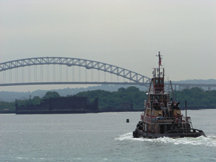The Port Authority of New York and New Jersey is considering a range of options as it studies how to raise the Bayonne Bridge, from building the existing roadway higher to installing a lift bridge section at the center to increase the height so the next generation of container ships will be able to pass under it, according to authority chairman Bill Baroni.
“The Port Authority has a responsibility to thoroughly evaluate each and every option, and in doing so, a variety of criteria are being considered,” Baroni said. “Last year, the Port Authority’s Board of Commissioners authorized $10 million to study the issue and identify the solution that balances the concerns of all interested parties,” Baroni said. “I am pleased to say this work is well underway, and that the Port Authority is poised to identify the most workable solution by the end of 2010.”
During a recent meeting with area real estate representatives, the Port Authority suggested that the lift bridge concept was its preferred option. A portion of the bridge would be reconstructed so it could be raised when ships approach and lowered again to allow auto traffic to pass.
“It is important to recognize the historic significance of the existing Bayonne Bridge.” – Gov. Christopher Christie
________
“It is important to recognize the historic significance of the existing Bayonne Bridge,” he said.
Raising the existing roadway would require extension of the ramps from their landing point at Fifth Street in Bayonne as far north as Eighth Street. Replacing the bridge would require some purchase of neighboring land, said local officials, some of whom said the Port Authority was in discussions with the owners of the neighboring Texaco tract, a 71-acre proposed redevelopment site.
Chris Patella, executive director of the Bayonne Local Redevelopment Authority (BLRA), the agency overseeing the redevelopment of the Texaco site into housing, said he was not aware of these discussions.
“If they are happening, we’re not aware of them,” he said.
Mayor Mark Smith said he was very concerned about the bridge and the misconception that the Texaco property might be purchased by the Port Authority.
“We’re not giving away the store here,” he said.
If the Port Authority buys the Texaco site, the property would drop from the tax rolls, leaving one less option for future development in the city and costing the city future revenue.
“The Port Authority has a responsibility to thoroughly evaluate each and every option,” Baroni said, “and in doing so, a variety of criteria are considered – project duration, cost, environmental impact, etc. I assure you that the effect of each proposed option on the residents of Bayonne will receive careful consideration.”
Searching for a balanced solution
In mid-September, the Port Authority Commissioners voted to commit $1 billion to fund the anticipated cost of solving the problem.
Baroni said, “In the end, the Port Authority will select the option that most carefully balances the needs of all.”
Steve Gallo, city business administrator, said the city hopes the project will keep to the current footprint and not infringe on property in the neighborhood.
Time is short for The Port Authority to solve the problem. The first new class of container ships is expected to reach the east coast at some point after the reopening of a widened Panama Canal in 2015. The bridge clearance is currently at about 151 feet, and the Port Authority’s aim is to provide 216 feet of space so ships can access ports Newark and Elizabeth on the other side.
This is not the first time the region has been confronted with this problem. In the 1960s, the federal government removed the Central Railroad bridge that ran across Newark Bay from Elizabeth to Bayonne in order to allow ships to pass unimpeded. Although this bridge did swing open to allow ship traffic to pass, a malfunction in the mechanism caused one of the worst train wrecks in local history and altered regional strategies that eventually led to removing the bridge.
While officials from the Port Authority may be leaning toward the lift option, the decision has not yet been made, Baroni said, but has the funds in place to move ahead in a timely fashion once the decision is made.
